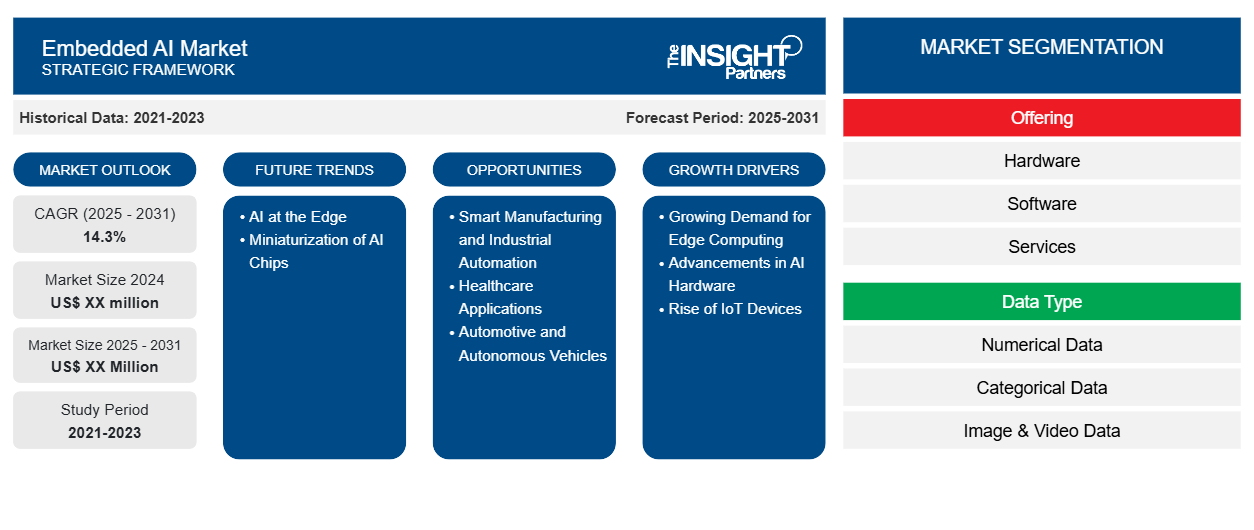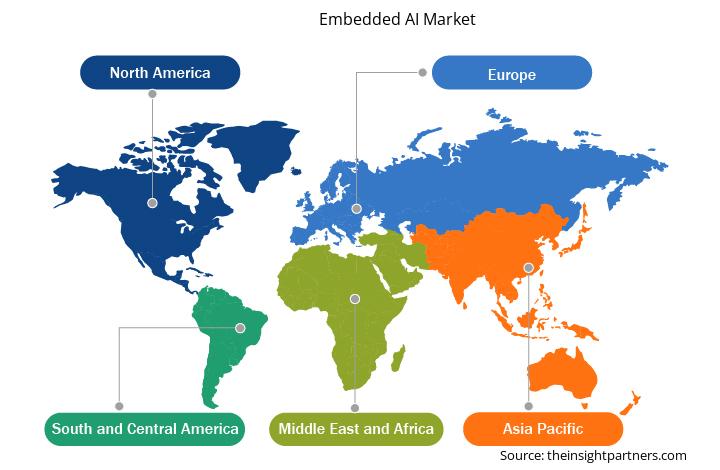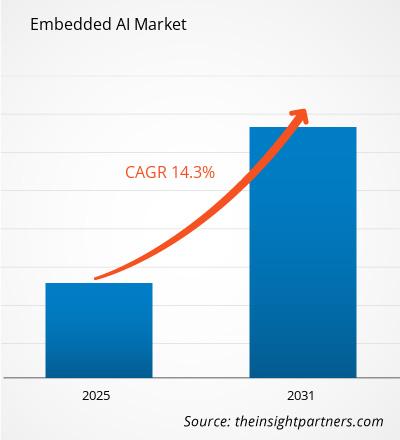嵌入式AI市场预计在2024年达到98.7亿美元,预计到2031年将达到256.8亿美元;预计在2025年至2031年期间的复合年增长率为12.4%。
该报告按产品(硬件、软件、服务)、数据类型(数值数据、分类数据、图像和视频数据)以及垂直行业(汽车、制造、医疗保健和生命科学、电信)进行细分。全球分析进一步细分为区域和主要国家。报告以美元为单位,列出了上述分析和细分市场的价值。
报告目的
Insight Partners 发布的《嵌入式人工智能市场》报告旨在描述嵌入式人工智能市场的现状和未来增长、主要驱动因素、挑战和机遇。这将为各业务利益相关者提供见解,例如:
- 技术提供商/制造商:了解不断变化的市场动态并了解潜在的增长机会,使他们能够做出明智的战略决策。
- 投资者:对市场增长率、市场财务预测以及整个价值链中存在的机会进行全面的趋势分析。
- 监管机构:规范市场政策和警察活动,旨在最大限度地减少滥用行为,维护投资者的信任和信心,维护市场的完整性和稳定性。
嵌入式人工智能市场细分
奉献
- 硬件
- 软件
- 服务
数据类型
- 数值数据
- 分类数据
- 图像和视频数据
垂直的
- 汽车
- 制造业
- 医疗保健与生命科学
- 电信
地理
- 北美
- 欧洲
- 亚太地区
- 中东和非洲
- 南美洲和中美洲
您可以免费定制任何报告,包括本报告的部分内容、国家级分析、Excel 数据包,以及为初创企业和大学提供优惠和折扣
嵌入式人工智能市场:战略洞察

- 获取此报告的顶级关键市场趋势。此免费样品将包括数据分析,从市场趋势到估计和预测。
嵌入式人工智能市场增长动力
- 边缘计算需求不断增长:随着数据生成的不断增加,对靠近源头的实时处理的需求推动了嵌入式人工智能的普及。嵌入式人工智能使边缘设备能够在本地处理数据,而无需依赖云端,从而降低延迟并提升自动驾驶汽车、智能制造和医疗保健等应用的性能。
- AI 硬件的进步:AI 芯片、GPU 和 FPGA 等专用 AI 处理器的开发正在加速嵌入式 AI 的发展。这些硬件组件针对 AI 任务进行了优化,具有低功耗、高性能和更小尺寸等特点,使嵌入式 AI 解决方案更加高效且可扩展。
- 物联网设备的兴起:物联网设备数量的不断增长是嵌入式人工智能的重要驱动力。随着物联网设备生成海量数据,嵌入式人工智能能够在智能家居、工业自动化和医疗保健设备等应用中实现本地化处理、智能决策和增强自动化。
嵌入式人工智能市场未来趋势
- 边缘AI:嵌入式AI市场的一个突出趋势是向边缘AI的转变,即AI处理直接在设备上进行,而不是依赖于云端。这一趋势的驱动力源于自动驾驶汽车、工业自动化和智能家居等应用对低延迟、实时决策的需求。
- AI芯片小型化:随着嵌入式AI设备体积越来越小、功能越来越强大,AI芯片也呈现出小型化的趋势。这些紧凑型芯片在低功耗的同时提供高计算性能,从而支持移动设备、可穿戴设备和其他小型电子设备中广泛的AI应用。
嵌入式人工智能市场机遇
- 智能制造和工业自动化:嵌入式人工智能通过实现预测性维护、质量控制和实时流程优化,为智能制造领域带来了巨大的机遇。人工智能系统可以监控机器、检测异常并自动执行生产任务,从而提高效率并减少制造工厂的停机时间。
- 医疗保健应用:医疗保健行业为嵌入式人工智能提供了巨大的机遇,尤其是在诊断工具、可穿戴设备和成像系统等医疗设备领域。嵌入式人工智能可以实现实时健康监测、个性化治疗建议和预测性诊断,从而增强患者护理并降低医疗成本。
- 汽车和自动驾驶汽车:嵌入式人工智能在自动驾驶汽车的发展中扮演着至关重要的角色。通过将人工智能集成到传感器、摄像头和控制系统中,汽车可以实时处理数据并做出驾驶决策,从而改善安全性、导航和交通管理,为汽车行业创造巨大的机遇。
嵌入式人工智能市场区域洞察
Insight Partners 的分析师已详尽阐述了预测期内影响嵌入式 AI 市场的区域趋势和因素。本节还讨论了北美、欧洲、亚太地区、中东和非洲以及南美和中美洲的嵌入式 AI 市场细分和地理位置。

- 获取嵌入式人工智能市场的区域特定数据
嵌入式人工智能市场报告范围
| 报告属性 | 细节 |
|---|---|
| 2024年的市场规模 | 98.7亿美元 |
| 2031年的市场规模 | 256.8亿美元 |
| 全球复合年增长率(2025-2031) | 12.4% |
| 史料 | 2021-2023 |
| 预测期 | 2025-2031 |
| 涵盖的领域 | 通过提供
|
| 覆盖地区和国家 | 北美
|
| 市场领导者和主要公司简介 |
|
嵌入式人工智能市场参与者密度:了解其对业务动态的影响
嵌入式人工智能市场正在快速增长,这得益于终端用户需求的不断增长,而这些需求的驱动因素包括消费者偏好的演变、技术进步以及对产品优势的认知度不断提升。随着需求的增长,企业正在扩展产品线,不断创新以满足消费者需求,并抓住新兴趋势,从而进一步推动市场增长。
市场参与者密度是指特定市场或行业内企业或公司的分布情况。它表明特定市场空间内竞争对手(市场参与者)的数量相对于其规模或总市值而言。
嵌入式人工智能市场的主要公司有:
- 谷歌
- IBM
- 微软
- AWS
- 英伟达
- 英特尔
免责声明:以上列出的公司没有按照任何特定顺序排列。

- 获取嵌入式 AI 市场顶级关键参与者概览
主要卖点
- 全面覆盖:该报告全面涵盖了嵌入式人工智能市场的产品、服务、类型和最终用户的分析,提供了整体概况。
- 专家分析:本报告基于对行业专家和分析师的深入了解而编写。
- 最新信息:该报告涵盖了最新信息和数据趋势,确保了业务相关性。
- 定制选项:此报告可以定制以满足特定客户要求并适合业务策略。
因此,嵌入式人工智能市场研究报告可以帮助引领解读和理解行业现状及增长前景。尽管存在一些合理的担忧,但本报告的总体优势往往大于劣势。
- 历史分析(2 年)、基准年、预测(7 年)及复合年增长率
- PEST和SWOT分析
- 市场规模、价值/数量 - 全球、区域、国家
- 行业和竞争格局
- Excel 数据集
近期报告
相关报告
客户评价
购买理由
- 明智的决策
- 了解市场动态
- 竞争分析
- 客户洞察
- 市场预测
- 风险规避
- 战略规划
- 投资论证
- 识别新兴市场
- 优化营销策略
- 提升运营效率
- 顺应监管趋势




















 获取免费样品 - 嵌入式人工智能市场
获取免费样品 - 嵌入式人工智能市场